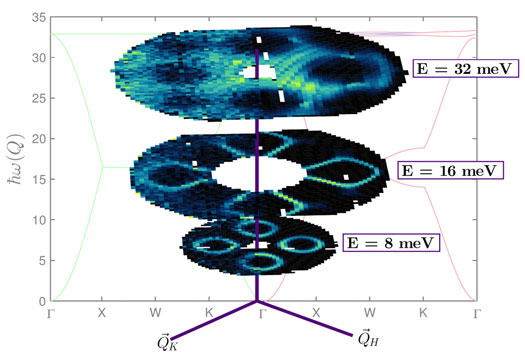| Posted: Nov 11, 2014 |
Unravelling the mysteries of topological heat transport
|
|
(Nanowerk News) A team of researchers from the LCN along with colleagues from the Paul Scherrer Institut and the ISIS spallation source have determined the microscopic origin of an unusual form of magnetic heat transport. In a recent edition of Physical Review Letters ("Spin-Wave Spectrum of the Quantum Ferromagnet on the Pyrochlore Lattice Lu2V2O7") the team reports on how magnetic ‘quasi-particles’, known as magnons, propagate in Lu2V2O7, the first material to exhibit the thermal magnon Hall effect: the magnetic transport of heat perpendicular to a temperature gradient.
|
 |
| The energy and momentum dependence of magnon propagation in Lu2V2O7. The colour slices at constant energy compare neutron scattering data (left) with the model (right).
|
|
The classical Hall effect occurs in electrical conductors when an applied magnetic field deflects electron trajectories so as to establish a transverse voltage proportional to the applied field. It finds many applications in sensor technology, including the compass app in the iPhone. The quantum Hall effect first discovered in the 1980s helped establish the importance of topology in condensed matter systems, a subject which has flourished in recent years. Topological insulators, for example, are a new class of material, which are insulating in the bulk but with conducting edge states that result from the combination of spin-orbit coupling in the presence of specific symmetries.
|
|
Lu2V2O7 has been conjectured to be the first example of a magnon topological insulator magnetic, with the thermal heat current carried by magnons playing the role of the electrical current in topological insulators. This classification, however, depends on the existence of strong spin-orbit coupling, required to deflect the trajectories of the heat carrying magnons. Indeed, the initial interpretation of the magnon Hall effect data required an exceptionally large value for the spin-orbit coupling, well above that predicted by some theoretical approaches.
|
|
Using inelastic neutron scattering the LCN team and collaborators determined the full magnon excitation spectrum in Lu2V2O7 allowing them to extract accuarte values of the relevant model parameters. Most importantly the team’s work independently establishes the existence of strong spin-orbit coupling in Lu2V2O7, consistent with its classification as the first realisation of a magnon topological insulator.
|
|
Since magnons carry elementary, discrete quanta of magnetic information, the team’s results could eventually lead to advances in the emergent fields of non-dissipative magnonics and spintronics, with potential application in devices.
|

